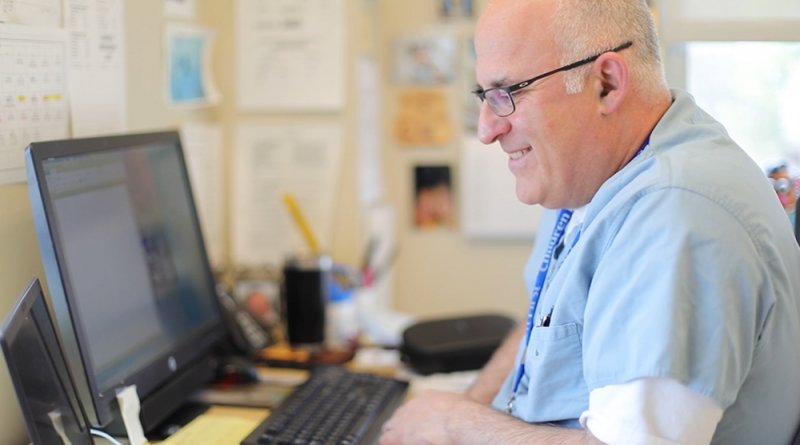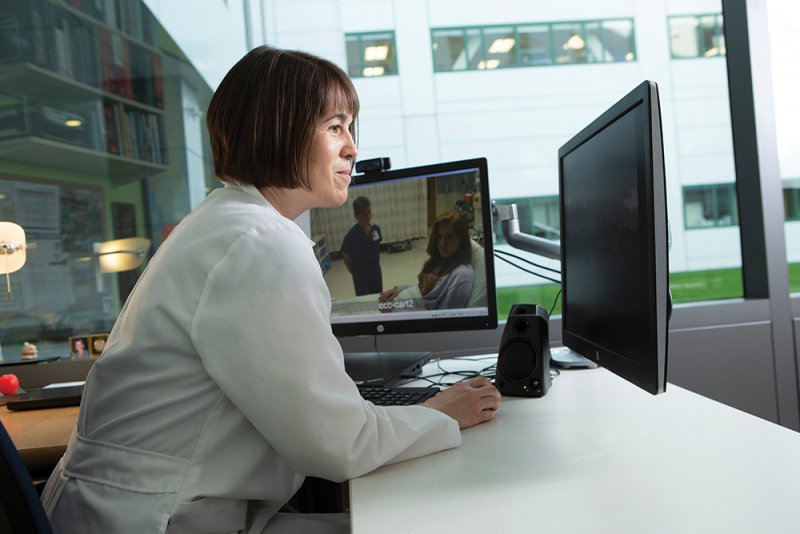 Dr. Andrew Rosen of SolutionHealth participates in a telemedicine appointment. Courtesy photo.
Dr. Andrew Rosen of SolutionHealth participates in a telemedicine appointment. Courtesy photo.
“Coming into the hospital can be a socially isolating experience, and during the height of the pandemic, we were preventing anyone other than hospital personnel and inpatients to be in the hospital.”The pivot to greater use of telehealth during the pandemic is both demonstrating how technology can be better incorporated into health care and helping to shape health care policy.
The earliest uses of telehealth or telemedicine were simply phone calls or video chats between a provider and a patient for consultation or follow-up care. They were mostly used for patients in rural communities who had limited access to in-office care. But, the pandemic has made telehealth ubiquitous and prompted legislative action to relax rules that limit its use.
Doctors are able to do their rounds remotely, visiting patients in hospital beds via a robot with a screen chatting virtually with patients.
In a recent webinar presented by the NH Telehealth Alliance, Dr. Jon Michael Vore, chief medical information officer for Southern NH Health in Nashua, says COVID-19, almost overnight, transformed the health care industry. “Patients still require care for chronic medical issues. There are new acute non-COVID issues and developing COVID-related issues,” he says. “How do we manage patients if we can’t bring them into the office?”
He says although both organizations within SolutionHealth—Elliot Health System in Manchester and Southern NH Health—had implemented telemedicine pilots, each used a different software platform and adoption was low among providers. When COVID-19 essentially shut down non-emergency services at hospitals, SolutionHealth sought to create a telemedicine system that would be easy to use for both providers and patients.
He says the new system had two phases: the first dealing mainly with outpatient care, then the second focused on inpatient uses. With a shortage of personal protective equipment, they looked for ways to decrease the number of times staff entered a patient’s room and had to don and doff protective gear. The solution was to issue iPads to staff as well as to patients who didn’t have their own device.
“This allowed us to conserve those precious resources … and allowed patients to communicate with their families,” he says.
“Coming into the hospital can be a socially isolating experience, and during the height of the pandemic, we were preventing anyone other than hospital personnel and inpatients to be in the hospital.”
Vore says the new telemedicine platform has been a success with hundreds of users registered and more than 76,000 telemedicine visits. Feedback from providers has also been positive. Examples of how the technology was used include dermatologists evaluating a skin lesion for melanoma and giving parents who could not visit their newborn in the neonatal intensive care unit a way to bond with their baby.
Telemedicine also helped to restore some revenue when all non-urgent care was on hold. “When we weren’t bringing as many people into the offices, there was a significant impact on revenue generation. These visits were starting to be reimbursed at in-office rates so, once again, it helped us bring revenue back into the organization.”
Breaking Barriers
While telemedicine has existed for more than 20 years, some of the primary impediments to wholesale adoption have been limited reimbursement, state licensing and practice restrictions—especially with regard to prescriptions—and cross-state coverage, says Dr. Keith Nelson, director of health care strategy at Connection, a technology provider in Merrimack.
During the pandemic many of those barriers were removed and recently adopted legislation will continue to expand telemedicine with such advances as electrocardiogram (ECG) shirts and wearables, remote robotic surgery and remote ultrasound and stethoscopes.
Care can also come to the patient in new and better ways. “When I went to school, there was just a school nurse; and there’s only so much availability to specialists at either K through 12 school or college … and you know it’s an all-day affair if you have to go to a doctor’s office,” says Nelson, pointing out telemedicine can help resolve those issues. He adds it also allows providers to see patients from other countries, expanding their markets and creating new revenue streams.
 Telemedicine technology in use at Dartmouth-Hitchcock Medical Center. Courtesy photo.
Telemedicine technology in use at Dartmouth-Hitchcock Medical Center. Courtesy photo.
Changes are still needed at the federal level to ensure providers are reimbursed when they treat Medicaid patients, says state Sen. Jay Kahn of Keene. Kahn, who sponsored a telehealth measure, says the NH legislature expanded the use of telemedicine with bipartisan support despite the disruption of the pandemic. The law now states that telehealth will be reimbursed at no more and no less than an office visit.
Part of the driving force behind telemedicine legislation was to increase the availability of mental health care, including the treatment of those suffering from substance use disorders.
A commission has been set up by Gov. Chris Sununu to review telehealth usage based on data from the Department of Insurance and health providers, which may include utilization and cost of services. The commission will make an interim report by Dec. 1, 2022 and the final report with findings and any recommendations for proposed legislation on or before
Dec. 1, 2024.

 Current Issue - April 2024
Current Issue - April 2024